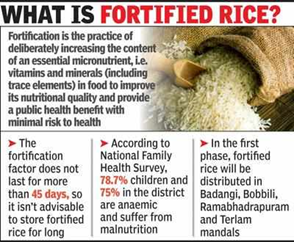

9th April 2022 (7 Topics)
Context
The Union Cabinet recently approved a scheme to distribute fortified rice under government programmes.
About
About
- Food Corporation of India and state agencies has already procured 88.65 LMT (lakh tonnes) of fortified rice for supply and distribution.
- The government announced the fortification of rice distributed under various government schemes, including the public distribution system (PDS) and midday meals in schools, by 2024.
Rice fortification:
- The Food Safety and Standards Authority of India (FSSAI) defines fortification as “deliberately increasing the content of essential micronutrients in a food so as to improve the nutritional quality of food and to provide public health benefits with minimal risk to health”.
- Various technologies are available to add micronutrients to regular rice, such as coating, dusting, and ‘extrusion’.
- The ‘Extrusion’ involves the production of fortified rice kernels (FRKs) from a mixture using an ‘extruder’ machine.
- It is considered to be the best technology for India.
- The fortified rice kernels are blended with regular rice to produce fortified rice.
- Under the Ministry’s guidelines, 10 g of FRK must be blended with 1 kg of regular rice.
- Fortified rice will be packed in jute bags with the logo (‘+F’) and the line “Fortified with Iron, Folic Acid, and Vitamin B12”.

How does the extrusion technology to produce FRK work?
- Dry rice flour is mixed with a premix of micronutrients, and water is added to this mixture.
- The mixture is passed through a twin-screw extruder with heating zones, which produces kernels similar in shape and size to rice.
- These kernels are dried, cooled, and packaged for use. FRK has a shelf life of at least 12 months.
- As per guidelines issued by the Ministry of Consumer Affairs, Food and Public Distribution, the shape and size of the fortified rice kernel should “resemble the normal milled rice as closely as possible”.
- According to the guidelines, the length and breadth of the grain should be 5 mm and 2.2 mm respectively.
Need of fortified rice:
- India has very high levels of malnutrition among women and children.
- According to the Food Ministry, every second woman in the country is anaemic and every third child is stunted.
- Fortification of food is considered to be one of the most suitable methods to combat malnutrition.
- Rice is one of India’s staple foods, consumed by about two-thirds of the population.
- Per capita rice consumption in India is 6.8 kg per month. Therefore, fortifying rice with micronutrients is an option to supplement the diet of the poor.



